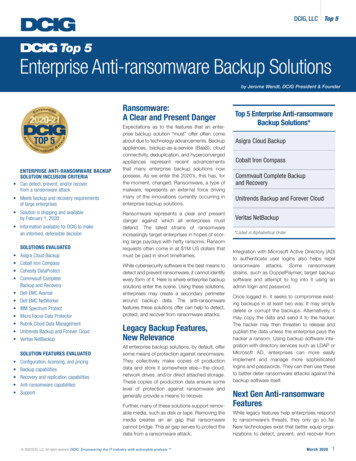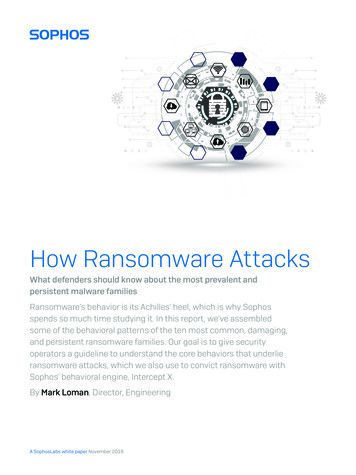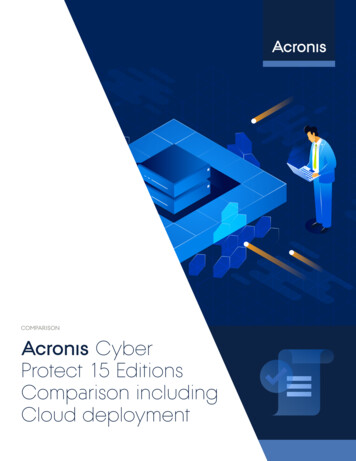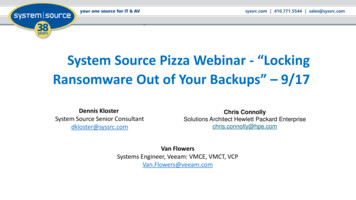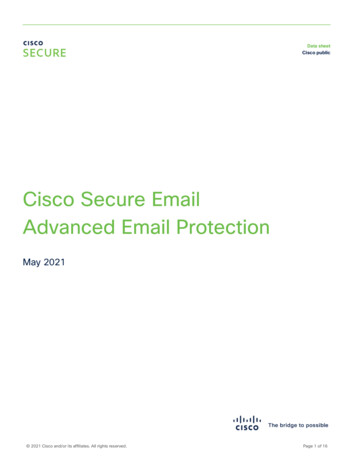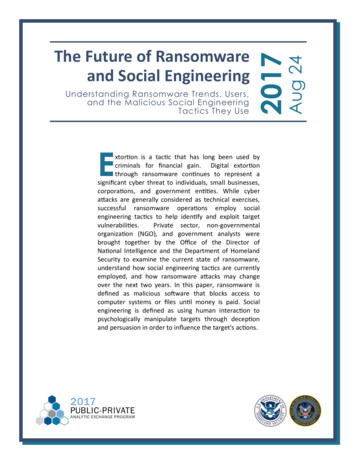
Transcription
Extortion is a tactic that has long been used bycriminals for financial gain. Digital extortionthrough ransomware continues to represent asignificant cyber threat to individuals, small businesses,corporations, and government entities. While cyberattacks are generally considered as technical exercises,successful ransomware operations employ socialengineering tactics to help identify and exploit targetvulnerabilities.Private sector, non-governmentalorganization (NGO), and government analysts werebrought together by the Office of the Director ofNational Intelligence and the Department of HomelandSecurity to examine the current state of ransomware,understand how social engineering tactics are currentlyemployed, and how ransomware attacks may changeover the next two years. In this paper, ransomware isdefined as malicious software that blocks access tocomputer systems or files until money is paid. Socialengineering is defined as using human interaction topsychologically manipulate targets through deceptionand persuasion in order to influence the target's actions.Aug 24Understanding Ransomware Trends, Users,and the Malicious Social EngineeringTactics They Use2017The Future of Ransomwareand Social Engineering
The Future of Ransomware and Social EngineeringTeam MembersNameOrganizationPeter M. (Champion)FBIRoss AlbertHUB InternationalKonstantin B.FBIAric JimenezSouthwest Texas Fusion CenterShane KeaneStratheron, LLCSteve ManciniNCFTAMichael OrrBPRob PantazopoulosFinancial IndustryPatricia P.FBIAshley ReichertIllinois Statewide Terrorism and IntelligenceCenterKelly WentzelWisconsin Statewide Intelligence Center2
Key Judgments While ransomware will continue to be used by financially motivated cyber actors, it will likely beincreasingly used for other purposes such as denial and deception, or combined with other cybertechniques. Cyber criminals may threaten to publish data online to extort additional ransom from the victim A ransomware attack can impact all facets of an organization. While the initial impact may belimited to whether the victim pays the ransom or not, the long-term effects of an attack may be farmore extensive and costly The number of attacks will increase due to proliferation of ransomware tools Ransomware attacks will likely expand to include targeting of Internet of Things (IoT) devices Social engineering will remain one of the easiest ways for a cybercriminal to gain access to acomputer system to deploy a ransomware attack. A variety of techniques that include technologyand methods of human manipulation will continue to be employed to collect this information.ScopeThis paper was prepared by the Future of Ransomware and Social Engineering team, operating under theauspices of the Department of Homeland Security’s Analyst Exchange Program. The paper was developedbased on open source research, interviews with identified subject matter experts, and participation inindustry conferences. All judgments and assessments are solely based on unclassified sources and are theproduct of joint public and USG efforts. The paper provides information concerning the current state ofransomware, the social engineering tactics used to support ransomware attacks, and an assessment ofwhere ransomware will likely go in the next two years.OverviewIn recent years, ransomware1 has received widespread media attention. Cyber threat actors havedemonstrated an ability to successfully target individuals, companies and governments with ransomwareall over the world, with victims including hospitals, police departments, universities, transportationsystems, and businesses. However, ransomware is not new. Since ransomware’s advent with the PCCyborg/AIDS Trojan in 1989, the mechanism for financial gain in ransomware has been quitestraightforward.i 2005 marked the beginning of modern ransomware, with variants using sophisticatedencryption to lock files on target computers and demand payment. Today’s ransomware operates on thesame model, but with even more sophisticated algorithms and larger keys, making brute force decryptionnearly impossible. Additionally, modern ransomware targets greater numbers of file types on the user'scomputer and network drives, increasing business networks’ vulnerabilities. As encryption becomes moredifficult to defeat, and as threat actors beyond purely financially motivated criminals continue to developnewer and greater capabilities, it is likely that intentions will go beyond simply encrypting files for thepurposes of extorting money from a victim.1Ransomware is a malicious software installed on a computer, network or service for the purpose of extortion. The malwareencrypts the victim’s data and/or systems making them unreadable. The victim will have to submit a monetary payment to acriminal(s) to decrypt files and/or regain access.3
The ransomware business model is a lucrative one for cyber criminals. The average ransom amountincreased from 294 in 2015 to 679 in 2016 and it is estimated that cyber criminals generated roughly 1billion from ransomware attacks in 2016.ii As ransomware continues to evolve, and the proliferation ofransomware tools continues, ransom payments will likely increase and comprise a larger percentage ofcybercrime costs in the near future.In addition to paying the ransom, victims suffer additional consequences such as the loss of data, downtime, reputational costs, and the expense of repairing or rebuilding their systems. According to an industryreport, downtime costs North American organizations up to 700 billion annually.iiiThe loss of data as a result of files being encrypted, can affect productivity and hinder operations. Less thanhalf of ransomware victims are able to fully recover their data after an attack. Without access toinformation needed to fulfill everyday tasks, productivity and operations could be hindered and potentiallyresult in lost sales and revenue.As the majority of ransomware attacks are conducted for financial gain, there continues to be a shift ofmoving away from targeting individual or home users to targeting companies or enterprise organizations.Although there may be more barriers to successfully infecting an organization, the profit expectation (ordemand) will be exponentially higher for an organization than an individual. In a 2016 study conducted byKasperskyiv, based on attack frequency, attacks against businesses grew by a factor of 3 while those againstindividuals grew by a factor of 2 from the first quarter of 2016 to the third quarter.Three sectors that may be particularly vulnerable to ransomware are small/medium size businesses, thehealthcare sector, and the education sector. The sectors, along with factors that make them vulnerable,are listed below. Small/Medium size businesses may lack the experience, infrastructure, and resources to maintain astrong awareness, understanding, and security posture to mitigate or remediate the threat. The Healthcare sector’s vulnerabilities include extensive use of legacy systems, delays in patchingand mitigating identified cyber threats in order to ensure safe operation of patient equipment, andwidespread access to sensitive patient information, that if compromised can affect patient healthand privacy.v The education sector is vulnerable due to the ease of attackers in obtaining staff information,decentralized information technology systems that increase the odds of vulnerable systems beingidentified, and similarities in organizational structures that allow attackers to use common attackstratagems.vi A recent report identified education as the most targeted sector for ransomware.viiVulnerabilitiesThe Internet of ThingsThe Internet of Things (IoT) refers to common or household devices that are “smart” or connected to theInternet. Examples include smartphones, coffee makers, wearable devices, washing machines, medicaldevices, and vehicles. IoT devices are already critically important in controlling power grids, water pumpingstations, and medical devices.viii By the end of 2017, 8.4 billion connected devices will be in use and that by2020, there will be more than 20 billion connected devices.ix IoT devices are an appealing target for aransomware operation because they are interconnected and lack the security measures that desktop orlaptop devices often have.x A private sector report claims that approximately 80% of IoT4
applications and 71% of mobile applications are not tested for security vulnerabilities, thus leavingthe door wide open to attackers. xiTraditional ransomware has affected computers, but the increase in the number of devices connected tothe Internet has provided the opportunity for systems to be controlled beyond computers.xii Kaspersky Labslabeled 2016 as “the year of ransomware”, and the near future does not give any indication these attackswill subside.xiii Cyber criminals already exploit IoT vulnerabilities on a large scale. In 2016 multiple websitesexperienced large scale distributed denial of service attacks (DDoS) that were launched from Mirai botnetsthat exploited weak security on IoT devices, primarily Internet-connected cameras and digital videorecorders.xiv On September 20, 2016, the KrebsOnSecurity website suffered one of the largest DDoSattacks ever recorded: between 600 billion and 700 billion bits per second for hours at a time, representingalmost half a percent of the Internet’s entire capacity.xv Ars Technica, hosted on a French server, alsoreported the same type of attack that peaked at 1.1terabits per second, which is 60 percent larger thanthe Krebs site attack. xviiiMany medical devices, such as a pacemaker, insulinpump, or drug dispersing devices are becomingInternet-enabled.xix There is little security or testingof implanted medical devices.xx Hackers know theimmediate need for these devices and could extortpatients out of a great deal of money due to thepatient’s dependency on them. The WannaCryransomware that affected thousands in May 2017appears to have hit medical devices. Radiologyequipment designed to help improve medicalimaging has also experienced ransomware infectionat a US hospital.xxiCritical InfrastructureThe number of critical infrastructure sitesdependent upon Internet connectivity to carry outtheir organization’s mission continues to increase.Critical manufacturing plants, water treatmentfacilities, transportation, and electrical powerentities are a few examples of the sectors thatoperate on industrial control systems (ICS) anddepend upon Internet connected operations. Many ICS systems lack strong security protocols. Previouscontrol systems were not designed for Internet connection capability, and many users make theassumption they are not on a public network and are not susceptible to an attack.xxiiAs a demonstration of these vulnerabilities, cybersecurity researchers at the Georgia Institute ofTechnology (GIT) developed a new form of ransomware to take over a simulated water treatment plant. xxiiiIn the simulated attack, researchers employed ransomware to gain entry into the system and thencommanded controllers to shut valves, increase the amount of chlorine added to water, and display falsereadings.xxiv The ransomware then locked infrastructure owners and operators out of the system until they5
paid the ransom demand. The researchers conducted this attack simulation to highlight how the ICS thatoperates facilities such as manufacturing plants, water, and wastewater treatment facilities, and buildingmanagement systems.xxv Although incidents such as this have not been reported in the real world, it islikely attackers will eventually employ attacks such as these. Similar to medical devices, these criticalinfrastructure sites and their operations are essential to vital services and needs for use and consumption.Cloud ServicesCloud Services are also vulnerable to ransomware attack. The cloud has enabled more efficient data andinformation storage by allowing users to save to services that run on the Internet instead of a computer.This has allowed employees to work remotely, increasing productivity, allowing for better collaboration,and saving money on their information technology (IT) infrastructure.xxvi In RightScale’s 2017 “State of theCloud Report,” 95% of organizations surveyed indicated they are running applications or experimentingwith “Infrastructure-as-a-Service (IaaS).xxvii IaaS is one form of cloud computing where an external providerprovides hardware and manages it via the Internet.xxviii The number of organizations that will be heavilyinvested in cloud computing in the future is expected to increase as many transition into full dependenceon cloud technologies. Xxix As the number of organizations that depend on cloud technologies rises, thenumber of opportunities for ransomware attacks against the cloud also increases. One of the mostcommon ways for an organization to have its cloud storage attacked is to open an infected e-mailattachment.xxxRecent DevelopmentsRansomware-as-a-Service Business ModelRansomware-as-a-Service (RaaS) allows cyber criminals to download a ransomware variant for free or anominal fee. After the ransomware is deployed, if a victim pays the ransom, the original author receives apercentage of the ransom as a part of the agreement. This service is appealing to novice hackers becausethe most complicated part of creating ransomware is handled; a beginner only has to buy the ransomware.The service is designed so that the attacker selects their victim, enters their BitCoin wallet address, anddeploys the malware.xxxi The service provider then takes a percentage of the ransom paid to theattacker.xxxii In May 2015, the first RaaS named “Tox” RaaS was discovered by McAfee Labs.xxxiii The attacker wasable to determine the ransom amount and include a message with the ransomware if desired. Thesite generated and downloaded the virus, which was then ready to be deployed. Tox took 20% ofthe total ransom payout.xxxiv Although Tox lacked complexity and efficiency within the maliciouscode, it is likely that it will evolve into a large business model.xxxvThe techniques of RaaS provide criminals of varying backgrounds the ability to operate in the undergroundmarket and conduct effective cyber schemes for financial gain. Ransomware variants in the undergroundmarketplace indicate the emergence of an advanced business model as capabilities provide enhancedanonymity techniques and custom solutions to criminals. Furthermore, as the ease of use in “do ityourself” ransomware packages becomes increasingly common, the business model caters to bothtechnically savvy and less sophisticated criminals.The following is an example of an advertisement detailing the capabilities provided by “crbr” or Cerberransomware:6
Complete anonymity of affiliates Real-time statistics of installs and payments on TOR affiliate panel Automated semi-monthly bitcoin payouts with options to request payout within 48 hours New binaries encrypted every 15 minutes for distribution by affiliates Ability to create sub-accounts with different ransom amount Referral system (5% additional earnings) Online support with ticketing system built into affiliate panel Actors running “Cerber” initially take 60% of the profits earned by affiliates. Cerber malware was capable of encrypting files without internet connection and did not containany form of command and control mechanism. Additionally, cerber demonstrated professional-levelcoding and a mature affiliate business model.xxxviRansomware Attacks That Do Not Require User InteractionThe recent WannaCry and NotPetya attacks were noteworthy in their ability to spread and infect computersystems through sophisticated techniques without user interaction. Ransomware variants that exhibitthese 'worm-like' qualities opens up another infection vector through the use of exploit kits, which aretoolkits designed to exploit security flaws in a variety of software applications normally for the purpose ofspreading malware.WannaCryThe WannaCry attack in mid-May 2017 affected organizations worldwide leveraging a Microsoft Windowsvulnerability. Microsoft had released the patches for this vulnerability two months prior to the attack further emphasizing the importance of patch management. A key takeaway regarding the WannaCryattack was its effectiveness without relying on social engineering. Unlike traditional social engineeringscenarios where user interaction is required, WannaCry utilized vulnerability (MS17-010) in Microsoft’s useof Server Message Block (SMB) to automatically spread to vulnerable Microsoft Windows (Server, XP, Vista,7, 8 and 10) networked devices using SMB.xxxviiShortly after the discovery of the WannaCry “kill switch”, there was widespread media coverage attributingthe attacks to amateur cyber criminals.xxxviii However, further research and analysis in the weeks followingthe initial WannaCry attack indicated possible linkages in the WannaCry malware code to that of codepreviously used by a North Korean State sponsored cyber group. This same North Korean group was alsoimplicated in the 2014 attack against Sony Pictures and a multi-million dollar heist on a Bangladeshi Bank in2016.xxxixNotPetya WiperNotPetya hit in late June 2017, and like WannaCry utilized the same SMB vulnerability in Windowsoperating systems. However, it added a layer of capability to spread via other means. Researchers quicklydiscovered NotPetya’s ability to extract credentials from an infected system, and in turn use the credentialsand legitimate Windows based tools to infect other computers on the same network.xl7
Further research showed that NotPetya was actually a destructive wiper that overwrote systems, butappeared to be ransomware.xli To date, this is one of the widest uses of ransomware as a smokescreen.The Ukraine based state security service, along with several security companies are initially attributing theactivity to a Russian state sponsored cyber group.xliiCyber Actors and Motivations for Using RansomwareRansomware can be used to generate financial gain, disrupt services, deny access to information, andserve as a cover for other types of cyber attacks or exploitation. Cyber actors ranging from individuals tonation states can use ransomware to accomplish their goals. The following graphic identifies the majorcyber actors, a characterization of their perceived relative technical abilities, key characteristics, andprimary motivations for conducting ransomware attacks.8
Social Engineering Facilitates Ransomware AttackWhile the recent WannaCry and NotPetya attacks demonstrate how cyber criminals can deployransomware via exploitation of a technical vulnerability, the easiest and most common way to deployransomware is still sending emails with malicious attachments. The most direct way to get into a computersystem is to simply ask permission. No matter how technically secure a network is, there is invariably ahuman factor that is susceptible to exploitation. Cyber actors use social engineering techniques to deceive,persuade, and influence targets for information that can be used to support a ransomware attack. Socialengineering is defined as using human interaction to psychologically manipulate targets through deceptionand persuasion in order to influence the target's actions. In this section we will explore the socialengineering cycle and some of the techniques cyber actors use to target potential victims.The Cycle of Social EngineeringSocial engineering typically consists of fourphases: xliii Information Gathering – collectinginformation to help identify attackvectors and targets. Relationship Development – developrapport with the target. Exploitation - Use information andrelationships to infiltrate the target. Execution – Accomplish ultimate goal.Oftentimes, however, social engineeringattacks are unique, with the possibility that itmight involve multiple phases and cycles, andmay even incorporate the use of other moretraditional attack techniques to achieve thedesired end result.xlivWhile there are in-person tactics that can be used to gather information useful in developing a strongransomware attack, our focus is on recognizing social engineering strategies that can be employed incyberspace or use hardware or software.Social Engineering TacticsPhishingA phishing attack occurs when the attacker sends an email to someone that appears to come from alegitimate user, often asking the target to visit a compromised website or open a malicious attachment.Phishing has many variations, such as whaling, where an attacker targets executives and high-profiletargets, the “big fish.” If the attacker is able to glean specific information about the target, such as a name9
or address, the attacker can take the phishing scam a step further and include this information in theemail to make it appear even more legitimate. xlvPhishing often takes advantage of information collected from social media, as users often willinglyprovide information via various social media sites. For example, on professional job websites, theattacker may pretend to be a job recruiter. Users post information about where they work, what theylike to do, what music they like, etc. The attacker can then use this information in a number of ways: To impersonate a friend listed on the page by sending an email asking for confidentialinformation; To view pictures of the target to determine locations they frequent and then appear at the samelocations to socially engineer the target outside of a work environment; To discover someone’s age, place of birth, school, and previous companies, which can all be usedto target the person in a spear phishing attack; To add someone as a friend to form an online relationship with them to build trust. The socialengineer then exploits that trust to get information from the target, which could be used tolaunch another attack; To send a private message to the target reference a position at a well-respected company thatsounds credible; directing the target to a phishing employment site, the attacker can then gathera great deal of information, and even require the user’s social security number for backgroundcheck purposes. At this point, the uses for this information are practically endless.xlviPretextingPretexting is presenting oneself as someone else in order to obtain private information.xlvii For example,a hacker may create an email address with a fake domain that looks like a targeted business executive inthe “from” name. The hacker would target an individual with direct or indirect ties to their spoofedexecutive. Next, the attacker would monitor to see when the target will be out of the office in order tobest execute their attack. For this attack, the hacker would then send a mobile text message relating to aproject with the company that would be familiar to the target, calling for action by the target to reviewthe attached files when they return to the office. Once the target returns and opens the attachments,they are infected. This technique specifically uses emotions and relationships to get employees to hastilytake action.xlviiElection SeasonAn attacker impersonates a campaign representative and calls the victim for a corporate donation. This istypically following a local election. If they pick the wrong candidate, they’ll try again in a few days withthe opposing candidate. The attacker will either build a website or ask for the credit card informationover the phone. To finish the attack, they will often make the user fill out a form that looks like an officialtax document, where they can gather more personal information about the target to reach out directlyto them in the future or use their information for further gain.xlix10
The Friendly Social EngineerIn this technique an attacker compromises a user’s email or social media account, and looks at recentmessages that the user has sent. Often, the initial target isn’t the final target. If any links or documentshave been sent, the attacker might follow up by saying they’ve updated the documents. For instance, iftargets exchanged PDFs, the attacker could send a newly updated version with malicious codeembedded. If the attacker can’t find a way to breach their final target with the initial account, they maycontinue to look for mutual friends and try to repeat the process again.lTyposquattingTyposquatting is when the attacker sets up a website with a similar domain name to a legitimate site andwaits. For example, instead of www.Legitsite.com, the attacker may register www.Legitsite.org. Thespoofed site will match the look and feel of the original. The idea is to wait passively for users whomistype a URL into their web browser. They will often be prompted to enter information, which is thencaptured by the adversary. The victim is then forwarded over to the legitimate site oftentimes logged inbut not realizing they were simply redirected and their information is now compromised.liDevice Left BehindAn attacker leaves a USB drive, CD-RW, phone or other storage device around an office or parking lot. Inorder to further entice the targets, the attacker writes a tempting label on it, such as salary informationor a famous musician. This tactic takes advantage of an individual’s curiosity. Also, to make sure the userthinks the device is legitimate (or to further increase their willingness to view the device), the attackerwill have files that sound enticing to open, for instance “XYZ Company Salary Records.xlsx”. The fileshave malicious software attached, thus resulting in the victim’s machine being compromised.liiReverse Social EngineeringReverse social engineering has three steps: sabotage, advertising, and assisting. In the first step, anattacker finds a way to sabotage a network. This can be as complex as launching a network attack againsttarget’s website or as simple as sending an email from a spoofed email address telling users that they areinfected with a virus. No matter what technique is employed, the attacker has either sabotaged thenetwork or given the impression that the network is sabotaged. Next, the attacker advertises theirservices as a security consultant. This can be done through many means including sending mailers,dropping business cards, or sending emails that advertise attacker’s services. At this point, the attackerhas created a problem in the network (sabotage) and is placing them in a position to help (advertising).The corporation sees the advertisement, contacts the attacker under the false pretense that the attackeris a legitimate consultant, and allows them to work on the network. Once in, the attacker gives theimpression of fixing the problem (assisting) but will really do something malicious, such as planting keyloggers or stealing confidential data.liiiSix Degrees of SeparationIn this technique, an attacker reaches out to the target’s friends or family, intending to develop arelationship with someone who can later “vouch” for them with the full intention of earning the trust ofthe target eventually. The victim will use their mutual contact to request an introduction to their target.At this point, the target is in a group setting, warmed up and comfortable, and the attacker can go afterviable information. While a group might seem like a bad idea because the attacker could get caught, itcould also lower someone’s guard, especially if the attacker doesn’t directly ask for sensitive information.11
The attacker can focus on the initial victim — the mutual friend that their prime target has so muchhistory with — and beat around the bush until they ask the question the attacker has been wanting toask themselves.livTechie TalkMany penetration testers and malicious hackers come from a technical background and not abackground in human psychology. As a result, when technical people need to do social engineering theyresort to a techie style. When an attacker calls up a user within an organization and impersonates a helpdesk operator the conversation on technical issues flows naturally and doesn’t prompt the user toproperly verify the “technician’s” credentials. Simply warning users of alleged compromise of passwordsand offering help to restore them sounds like routine IT assistance that can harvest valuable accessinformation.lvCause a Panic and Take AdvantageIn this situation, an attacker reaches out to a user informing they’ve been compromised and the attackerclaims to represent a technical support individual or a help desk employee. Through data available on theDark Net, for instance, there are numerous cases of Dell records, including service number and servicecall dates and information that hackers can use to not only reach out to a user but truly convince themthey are technical support. Now the attacker talks to the user, saying the user needs to reset theirpassword to meet complexity requirements, enable remote desktop access or even install a file throughthe command prompt. The attacker walks them through this process. After the task is completed, theattacker asks if they can help with anything else and informs the user that there is maybe a surveyfollowing this call which could be performed by the attacker’s accomplice. They do this to make it seemauthentic and because people tend to remember the beginning and end of conversations, but not themiddle. By exiting the conversation gracefully or even adding another voice through a survey, they makeit seem more authentic.lviVishingVishing is an attack that uses the phone to perform the equivalent of a phishing attack. The typical targetfor this kind of social engineering tactic is a corporate executive. An attacker will call with a pre-recordedmessage, pretending to be the victim’s company or the company’s bank. The attacker will ask the user tocall a phone number, and in doing so, they will ask for their credit card info, phone number, pin, last fourdigits of their social security number and other sensitive details. At this point, the at
Social engineering will remain one of the easiest ways for a cybercriminal to gain access to a computer system to deploy a ransomware attack. A variety of techniques that include technology and methods of human manipulation
